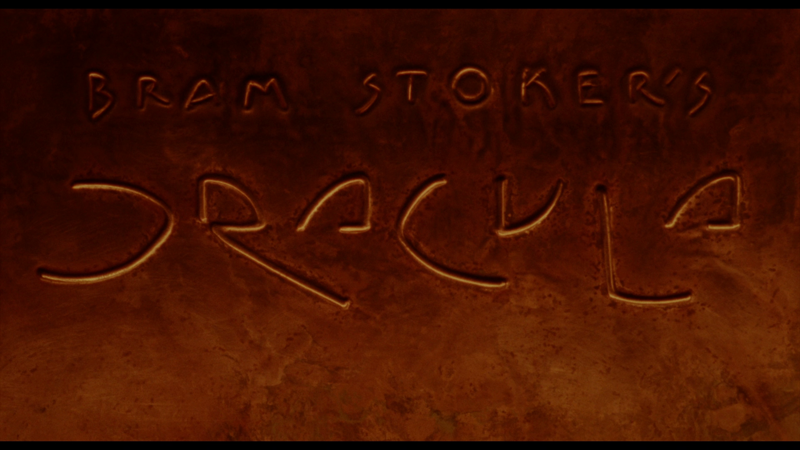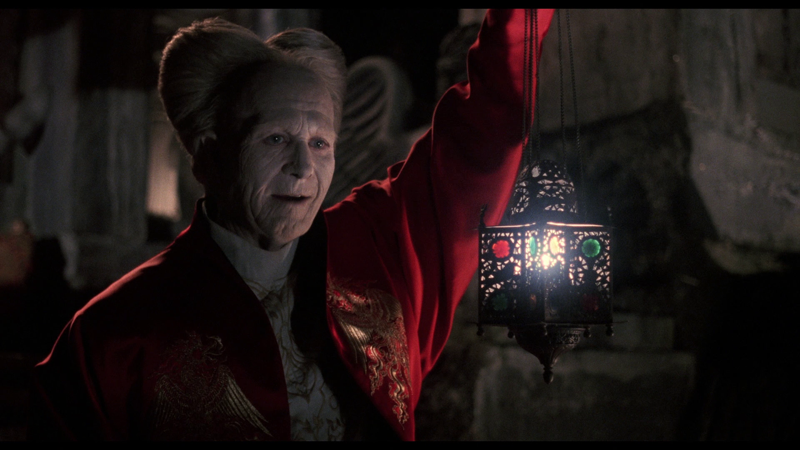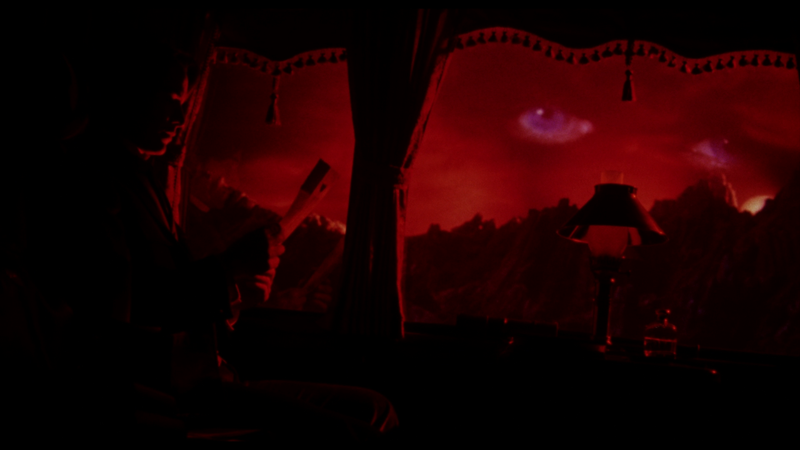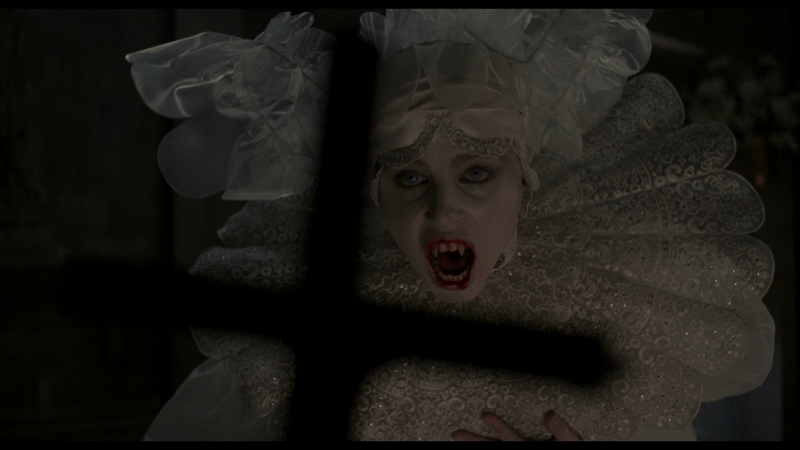| Reviews & Columns |
|
Reviews DVD TV on DVD Blu-ray 4K UHD International DVDs In Theaters Reviews by Studio Video Games Features Collector Series DVDs Easter Egg Database Interviews DVD Talk Radio Feature Articles Columns Anime Talk DVD Savant Horror DVDs The M.O.D. Squad Art House HD Talk Silent DVD
|
DVD Talk Forum |
|
|
| Resources |
|
DVD Price Search Customer Service #'s RCE Info Links |
|
Columns
|
|
|
Bram Stoker's Dracula Supreme Cinema Series
Coppola's gothic love story, beautifully repackaged

Reviewer's Bias*
Loves: Bram Stoker's Dracula
Likes: Unique packaging, Winona Ryder
Dislikes: Digibooks, Keanu Reeves' accents
Hates: Double dips
The Movie
Back in college, I once part of a discussion with some film major friends about whether a movie could be so impressive visually that it could overcome a poorly-written script and still be a good movie. Though no consensus was reached, watching Francis Ford Coppola's version of Bram Stoker's Dracula feels like a pretty strong argument for the idea that visuals could trump writing. It's not that it's poorly written, but the plot is hardly key to enjoying the film, which is a marvel of old-school cinema magic and a true work of art.
Hewing far closer to the original Stoker book than any previous Dracula adaptation, while incorporating elements of the real Vlad the Impaler and a new love story courtesy of screenwriter James V. Hart, Coppola pulls back on the traditional horror-movie elements and aims to tell more of an emotional tale. After effectively establishing an origin in the prologue, the focus falls on Mina (Winona Ryder) and Dracula (Gary Oldman), a pair of lovers in a previous life, brought together by chance through Mina's fiance Jonathan (Keanu Reeves), a real estate agent working with the Count to acquire land in London. With the vampire seeking to regain his lost love, it's not a good idea to get in his way, and a trail of bodies is left in his wake, with only Van Helsing (Anthony Hopkins) and company standing in his way.
Though the story is pretty straightforward, told with the same epistolary devices found in the book, there are moments where the plot takes a backseat to simply establishing a creepy tone, which is done well, particularly when the various forms of Dracula are explored, including a wolf-like creature, a half-man, half-bat version and the ultimate in creepiness, the elderly Dracula, in a red robe and high hair. Oldman is perfection no matter which version he's portraying, from the armored warrior of Transylvania to the suave, suit-wearing prince in London, managing to make one of the most terrifying characters ever both charming and sympathetic. He's also responsible for one of the most disturbing laughs in film history.

While Cappola drenches his film in creepy, he also establishes a definite sense of the erotic, be it with Mina's adventurous pal Lucy (Sadie Frost) or Dracula's sexy brides (featuring the lovely Monica Bellucci.) Though there's frequent topless nudity from both Lucy and the Brides, the eroticism goes beyond the simple reveal of flesh, as self-control is often tested and temptation is as deadly a weapon as any gun or sword. Dracula has always been tied to the erotic, but few mainstream films make it such an integral ingredient, and putting that power up against the more restrained setting of turn-of-the-20th Century London, it creates a tension that's palpable and enhances the sense that something wrong is going on. But for the first time, it seems like it's not Dracula that's the one at fault.
Ryder is perfectly cast as the romantic Mina, torn between what she knows she should want in life and what she feels she desires, while Keanu Reeves is also in the movie. (Not to join the critical dogpile on Reeves, who seems like a genuinely nice guy, but combine this film with Much Ado About Nothing and it's clear he shouldn't attempt accents. Or period pieces.) Hopkins gets to cut loose a bit as Van Helsing, but he's such a tangential part of the film, almost acting as comic relief, that it is very easy to forget he is in the movie. Frost, on the other hand, is hard to forget, for very obvious reasons. The same goes for Tom Waits, whose memorable turn as the unfortunate Mr. Renfield reminds one how he's way more than just a musician.
Though Bram Stoker's Dracula is a tremendous film for what ended up on-screen, the process used to create that imagery is part of the reason why it's such a classic film, with a mix of traditional techniques that allowed effects to be achieved almost entirely in a practical method, avoiding modern conveniences like CGI. Putting such tools--including double exposures, stop-motion animation and even a hand-cranked Pathe camera--into the hands of an artist like Coppola (who was aided by his son Roman) results in a film that bridges the gap between the older classics and modern masterpieces via truly striking, organic compositions that look like few other films. There may be visual trickery at hand, but it all offers more realism than any computer could muster. Even if you didn't know how it was done (which you'll learn in the extras), you'd still know it's not like the other movies out there.

The Disc
The first in Sony's new Supreme Cinema Series, the film arrives on one Blu-ray, which is packed in a unique digibook. The front and back covers are made of a thick clear plastic that looks like glass, with a red fabric-like binding across the spine, which approximates the look of a hardcover book. On that binding is a spot UV coating that looks like dripping blood, while the film's name is stamped in gold foil on the spine. There's no name on the cover, which makes a striking impression with the shot of Dracula licking blood off a razor. Inside the covers is a well-designed 26-page booklet, while the disc sits in a slot in the last page. Overall, a beautiful, unique package, even if slot-held discs are not an ideal storage solution. The Blu-ray features a simple static menu, with options to watch the film, select scenes, adjust the setup and check out the extras. Audio options include an English Dolby Atmos 7.1 track (TrueHD 7.1 compatible), as well as English, Spanish and French Dolby Digital 5.1 tracks, while subtitles are available in English, English SDH, Spanish and French.
The Quality
The 1080p. AVC-encoded transfer here is struck from a new 4K master, and it's bound to start all new arguments about proper video presentation. Though many of the issues some viewers had with the previous director-approved transfers, involving the clarity and detail of the image, have been resolved with this sharp, wonderfully detailed transfer, the color question will remain a point of contention until Coppola himself deems it worth a statement (personally, the color looks fantastic--well-saturated and vibrant where it should be.) This new version, however,introduces a new wrinkle, as the framing has been altered since the previous releases, often shifting the image up more. The change is hardly perceptible without matching up screenshots of various releases, and often results in a somewhat more pleasing positioning of elements on-screen. There are two problems though, one being the inconsistency in this shift (which makes one wonder why it occurred) and the other being, if Coppola approved the previous version, why change the framing here? Other than the issue of the positioning, this release looks terrific, and lets you fully appreciate the artistry on display, with a stable, appropriate layer of grain, solid black levels and no hint of digital distractions.
If you have a Dolby Atmos set-up, good on you. You're doing well in life. For the rest of us, the TrueHD 7.1 presentation the disc kicks over to in the absence of an Atmos-ready receiver will have to do. Fortunately, second-best is pretty great. Bram Stoker's Dracula offers a little bit of everything in terms of audio variety, from the beckoning whispers of Dracula's brides to the rumble of a thunderstorm, and this track delivers everything crisply, creating an enveloping soundstage that lends the right mood to the film, particularly in terms of the atmospherics in the surrounds, which offer up details that round out scenes with excellent positioning. Dialogue is clear and easily understood throughout (mostly from the center channel, with some spillover) while the beautiful score gets a boost from the sides and rear. The low-end is a bit of a non-starter, but that's because of the content, not the mix.
The Extras
Most the bonus content on this disc was available on the previous DVD and Blu-ray releases like the introduction from Coppola (3:55), where he talks about Stoker's book, his personal connection to the story, past cinematic adaptations and his approach to the film. However, Sony's stepped up with a few quality additions, starting with a commentary featuring both Francis and Roman Coppola, as well as makeup supervisor Greg Cannom (with the three solo participants edited together) which joins the solo Coppola commentary found on the previous collector's edition DVD and Blu-ray discs. The three-part track was first available on Criterion's 1993 laserdisc of the film, so it's great to see it available again, avoiding the fate of so much of the bonus content for films to which Criterion has lost the rights. Impressively, between the two tracks, there's a minimal amount of overlap, as the solo track was recorded 15 years after the film was released, giving it a different perspective, while the Criterion commentary is mainly about how the various effects were achieved, along with some inside baseball, as Francis Ford Coppola discusses dealing with the ratings board and the differences in the film's reception domestically and abroad. Though there's plenty to like about the three-person track from a filmmaking perspective, the solo track is more of an "honest" conversation about the movie, including talk of battles with the studio, Oldman and the film's DP, as well as a more top-level look at the inspirations on and approach to the film. Together, they cover most anything you'd want to know about Bram Stoker's Dracula.
That's a slight problem as you head into the six featurettes included, as much of what is discussed is covered in the commentaries, in the same words, since the two Coppolas are oft-present in these pieces. (Interestingly though, you'll notice some stories, particularly one about someone who started but didn't finish on the movie, change over time.) That said, it's more than just those two on-board, and getting to see the archival footage offered is much appreciated as well. However, the two new featurettes, "Reflections in Blood: Francis Ford Coppola and Bram Stoker's Dracula (29:11) and "Practical Magicians: A Collaboration Between Father and Son" (20:07), feature only the Coppolas, interviewed by critic F.X. Feeney. Thus, it's in these two featurettes that the overlap with the commentaries is at its highest, which makes sense since it's once again their memories of the film. There are some new items included though, like what it was like for Roman to grow up on his father's film sets and what the film's success meant for the family, as well as the identity of the actor who had been cast as Harker before Reeves' last-minute hiring. Despite the overlap. both are well worth watching.
The remainder of the featurettes are carried over from the previous Blu-ray and the most-recent DVD, starting with "The Blood is the Life: The Making of Bram Stoker's Dracula" (27:48). In this one you get to hear from almost the entire cast (minus Ryder and Waits) as well as Coppola and Hart, as they talk about the experience of making the film. Though the interviews are engaging, especially Oldman's, it's the archival footage that's the draw here, as you get a ton of on-set footage, including looks at the unique rehearsal process, Coppola's directorial style and battles between Coppola and Oldman on-set, which are great to watch. It's a perspective few films offer to viewers.
"The Costumes are the Sets: The Design of Eiko Ishioka" (14:02) puts the focus on the gorgeous costume design in the film, courtesy of the late Japanese artist who earned an Oscar for her first attempt at costumes. This piece talks about how she got the job, her influences in the Dracula work, a close look at some of the key costumes and the challenges she faced.
The film's look gets more attention in "In Camera: Naive Visual Effects" (18:46), which explores how the filmmakers achieved the special effects in the film without post-production work, through interviews with Francis and Roman Coppola, as well as another father and son team, camera operator Christopher Lee Warren and effects supervisor Gene Warren, Jr. The key here is the test footage shot in preparation for production, as you get to see just how the movie's visuals came together.
"Method and Madness: Visualizing Dracula" (12:06) looks at another part of the pre-production effort, as Coppola did full animatics for the movie (referred to in 1992 as "The Score") for which he brought in a narrator and sound effects to create filmed storyboards for planning out the film. Though far more common today, the effort seen here remains impressive. If only more of the animatics could be seen here,
Also available are 12 deleted or extended scenes, which run a combined 28:14. These are in very rough workprint shape, but they give a great idea of how the film was edited down into the tight package it was when it hit screens. The difference between these plodding, dialogue-heavy moments and the crisp scenes is the film is like night and day.
Two trailers, one the effective theatrical promo (2:36), the other a slightly cheesy teaser (1:31), wrap up the packages. Two things to note here: based on the theatrical trailer, you'd have no idea Reeves is in the film, and the teaser uses an entire screen to emphasize that Hart is the screenwriter, which just seems bizarre from a marketing standpoint.
In the digibook packaging, on thick, glossy stock, there's an introduction from Coppola (which covers much of the same ground as his participation in the on-disc extras) as well as an uncredited "The Story of Bram Stoker's Dracula", a 15-page history of the production. Though clear and info-filled, it's a bit sanitized, leaving out all of the personnel issues mentioned in the commentaries and featurettes.
Also included in the package is a code for an Ultraviolet stream/download.

The Bottom Line
Bram Stoker's Dracula is truly a work of art, a moody love story where the atmosphere and visuals are probably more important than the story itself. It's a tribute to a by-gone era and a beautiful film all around. The quality of the presentation, though sure to be controversial due to changes from previous releases, leaves the movie looking and sounding as good as it ever has, while the new package, as part of Sony's Supreme Cinema Series, is extensive and well-crafted, inside and out. The results are as Criterion as anything not made by Criterion (aside from the one commentary) has come.
Francis Rizzo III is a native Long Islander, where he works in academia. In his spare time, he enjoys watching hockey, writing and spending time with his wife, daughter and puppy.Follow him on Twitter
*The Reviewer's Bias section is an attempt to help readers use the review to its best effect. By knowing where the reviewer's biases lie on the film's subject matter, one can read the review with the right mindset.
|
| Popular Reviews |
| Sponsored Links |
|
|
| Sponsored Links |
|
|
| Release List | Reviews | Shop | Newsletter | Forum | DVD Giveaways | Blu-Ray | Advertise |
|
Copyright 2024 DVDTalk.com All Rights Reserved. Legal Info, Privacy Policy, Terms of Use,
Manage Preferences,
Your Privacy Choices | |||||||













